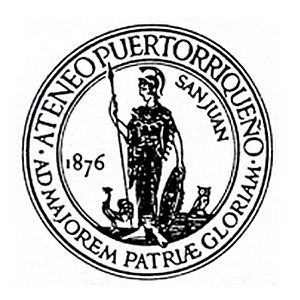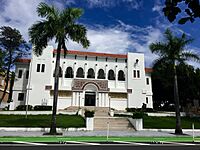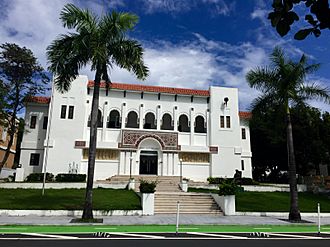Ateneo Puertorriqueño facts for kids
 |
|
<mapframe text="Ateneo Puertorriqueño" width="225" height="225" zoom="13" latitude="18.466278" longitude="-66.109040"> { "type": "Feature", "geometry": { "type": "Point", "coordinates": [-66.109040, 18.466278] }, "properties": { "title": "Ateneo Puertorriqueño", "description": " ", "marker-symbol": "museum", "marker-size": "large", "marker-color": "0050d0" } } </mapframe> ", "marker-symbol": "museum", "marker-size": "large", "marker-color": "0050d0" } } </mapframe> |
|
| Nickname | "El Ateneo" (English: "The Athenaeum") |
|---|---|
| Named after | Athenaeum |
| Founded | 30 April 1876 |
| Founders | Manuel de Elzaburu y Vizcarrondo, José Julián Acosta, Alejandro Tapia y Rivera, and Francisco de Paula Acuña y Paniagua |
| Founded at | San Juan City Hall |
| Type | Not-for-profit cultural institution |
| Registration no. | 352044 |
| Purpose | Promote the affirmation and development of the Puerto Rican nationality, as well as engage in cultural, educational and social activities. |
| Headquarters | Puerta de Tierra, Old San Juan, San Juan, Puerto Rico |
| Location | |
|
Region
|
Puerto Rico |
|
Official language
|
Spanish |
| Junta de Gobierno del Ateneo Puertorriqueño | |
| Endowment | $466,636.00 (2018) |
| Puerto Rican Athenaeum Ateneo Puertorriqueño |
|
|---|---|
 |
|
| General information | |
| Architectural style | Spanish Morisco |
| Groundbreaking | 27 May 1923 |
| Technical details | |
| Floor count | 2 |
| Design and construction | |
| Architect | Francisco Roldán Arce |
| Other information | |
| Parking | 14 (Disabled: 1) |
|
Ateneo Puertorriqueño
|
|
|
U.S. Historic district
Contributing property |
|
| Part of | Puerta de Tierra Historic District (ID100002936) |
| Designated CP | October 15, 2019 |
The Ateneo Puertorriqueño (which means Puerto Rican Athenaeum) is a very important cultural place in Puerto Rico. It was started on April 30, 1876. Many people call it Puerto Rico's oldest cultural group. However, it is actually the third oldest overall and the second oldest cultural group. The Bar Association of Puerto Rico and the Casino of Mayagüez are older.
One of the people who helped start it was Alejandro Tapia y Rivera, a famous writer. The Athenaeum was the first place to give special awards to artists and writers. Some of these famous people include José Gautier Benítez, José de Diego, Francisco Oller, Lola Rodríguez de Tió, and Luis Lloréns Torres.
Today, the Athenaeum is like a museum, a school, a library, and a place for performances. It holds many contests, talks, and art shows every year. These events celebrate Puerto Rican art, books, and music. Since 1937, the building has mostly been used for events that the Athenaeum itself organizes. It is located in Puerta de Tierra, right next to Old San Juan. This area also has other important buildings like the Casa de España and the Capitol of Puerto Rico.
Contents
History of the Athenaeum
The Athenaeum began on Sunday, April 30, 1876, at the San Juan City Hall. Alejandro Tapia y Rivera, a well-known playwright, was one of its founders. This institution was the first to honor and give awards to many talented Puerto Rican artists and writers. These included famous names like José Gautier Benítez, José de Diego, Francisco Oller, and Lola Rodríguez de Tió.
In 1946, Nilita Vientós Gastón became the first woman to be president of the Athenaeum. She led the institution until 1961. In 1976, the Athenaeum celebrated its 100th birthday. Eladio Rodríguez Otero was the president at that time. He gave a speech with important guests like the governor, Rafael Hernández Colón. To remember this special event, the Athenaeum created a medal. This "Centennial Medal" is given to people who show the best of Puerto Rican culture. The musical group El Gran Combo recently received this award.
The Athenaeum Building
In 1922, an architect named Francisco Roldán Arce was asked to design the building we see today. The first stone of the building was placed on May 27, 1923. This happened with José Coll y Cuchí present. The building's style is called Spanish Morisco. This style was brought to Puerto Rico by Pedro Adolfo de Castro. He also designed other buildings nearby. This style uses bright spaces, galleries, and balconies. These features help connect the inside of the building with the outside.
The Athenaeum Art Gallery
The Athenaeum is very proud of its art gallery. It has 459 pieces of art. One of the most famous paintings there is "La Escuela del Maestro Rafael Cordero" by Francisco Oller. This painting was made in 1890.
Membership Types
The Athenaeum has different types of members:
- Founders: These were the 48 people who joined before the Athenaeum officially opened.
- Of Merit: These are people who have done great things for the Athenaeum.
- Of Number: This is a general membership type.
- Accidentals: These members pay their monthly fees to be part of the Athenaeum.
Educational Programs
The Puerto Rican Athenaeum invites important people from Puerto Rico's cultural world to teach and share their knowledge. These experts cover many different subjects.
Experimental Theatre
The Athenaeum has been involved with theater for a long time. It started with the help of Alejandro Tapia y Rivera. Theater contests have been held there since 1911. In 1938, Emilio S. Belaval started the first professional theater groups. The Experimental Theatre of the Puerto Rican Athenaeum began in 1952. It was the first theater company to be part of the institution.
A famous Puerto Rican playwright, René Marqués, started a project to create and share plays. This project continues today. It has led to over 500 plays being performed. It also includes 26 Avant-Garde Theatre Festivals. Many actors and theater people in Puerto Rico have been part of these festivals. The Experimental Theatre Hall can hold 200 people. Many famous Puerto Rican plays had their first performance here. One of the most well-known is René Marqués's play, La Carreta, which premiered in 1953. Other important playwrights whose works premiered here include Manuel Méndez Ballester and Francisco Arriví.
Theatre Festivals
The Theatre Festivals of the Puerto Rican Athenaeum started in the 1970s. Their goal is to show new plays, both from Puerto Rico and other countries. Between 1973 and 2003, there were 36 Theatre Festivals. In most festivals, about 10 plays were shown. However, in the 19th festival, twenty plays were performed. Fifteen of these were by young or well-known Puerto Rican writers. The 20th festival showed 26 plays.
Music Programs
The Music Chair was one of the first programs created in the 20th century. It is in charge of the Athenaeum's String Quartet.
Contemporary Puerto Rican Music Festival
This festival started in 2005. It has been held eight times since then. It celebrates modern Puerto Rican music.
Cinema and Video Programs
The Cinema and Video Chair was created in 1985. It helps develop movies in Puerto Rico. It also works to create plans and ways to fund the local film industry. So far, it has helped produce two full-length movies.
The “Decolonization Torch”
A sculptor named José Buscaglia Guillermety designed a sculpture called "La Antorcha de Descolonización." This means "The Decolonization Torch." It was made to show Puerto Rico's right to a non-colonial political status.
The sculpture was officially revealed on the night of July 24-25, 2007. This happened in front of the Athenaeum Building. It will stay there until the United States helps Puerto Rico solve its issues as a colony. Many important people from politics, culture, and sports attended the event. The sculpture has the words "Fin a la Colonia" engraved on it, which means "End to the Colony."
Public Memorials at the Athenaeum
The Athenaeum has often been a place where public memorials are held for important people.
On March 4, 2015, a memorial was held for the actor Braulio Castillo. The Athenaeum keeps his film collection and documents about his career.
In March 2017, a memorial was held for the actress and writer Brunilda García.
On November 7, 2019, a memorial took place for the television astrologer Walter Mercado. Governor Wanda Vázquez Garced attended and declared a day of mourning.
On January 3, 2020, a memorial was held for Marisa Rosado. She was an activist and author, known for her book about Pedro Albizu Campos.
On March 6, 2020, a memorial was held for Rafael Cancel Miranda. Female members of the PIP gathered to greet him at the building's stairs.
See also
 In Spanish: Ateneo Puertorriqueño para niños
In Spanish: Ateneo Puertorriqueño para niños

